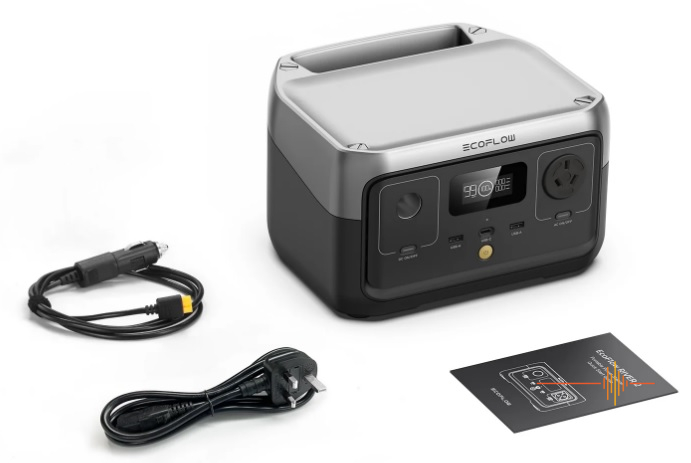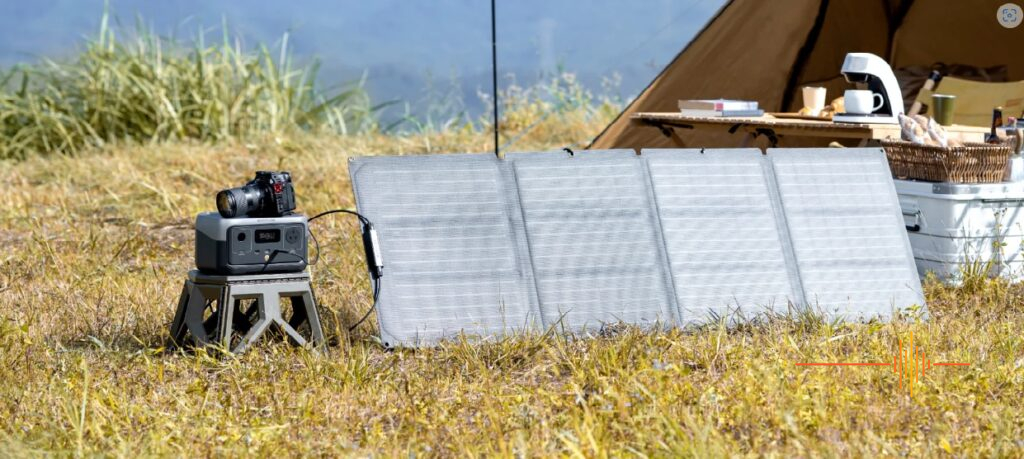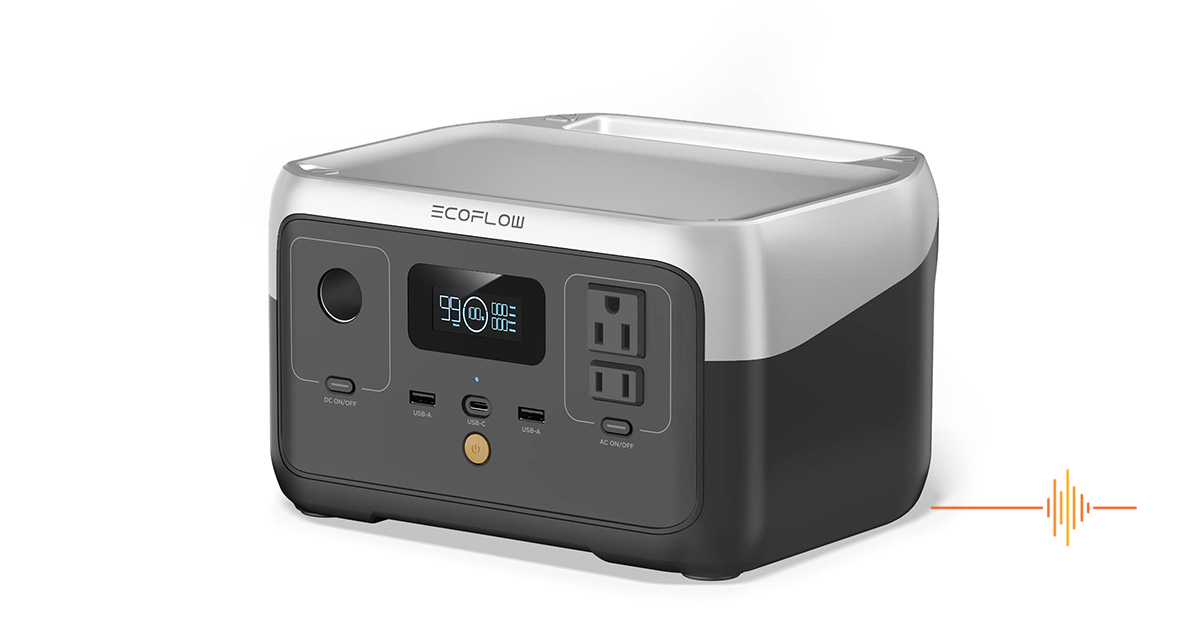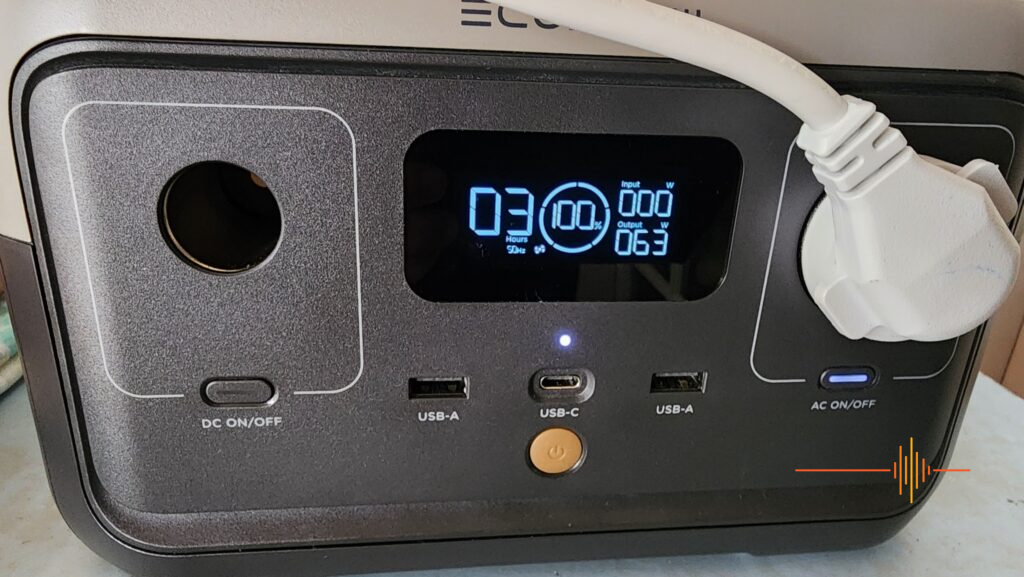DRN announced the new Ecoflow River 2 series of Portable Power Systems here on this site very recently.
Check that overview of the main features of the EcoFlow line-up here.

That will be a good introduction for this review where we explain (and test) the following number sequence: 1, 3.5, 4, 5, 10, 256, 300, 600 and 649.
No, it not the famous Fibonacci sequence but these are the key numbers that define this EFR600 model of the River2 series.
Just like 36-24-36 typified the ideal figure in the model world, I suppose…
Before we explain why these numbers make this River 2 such a powerful go-anywhere source of energy for our electronic lifestyle, let’s admire the beauty of this beast first.
The River 2 PPS is very much like a UPS type powerpack you can carry with you.
And you would not feel ashamed to do so.
Whereas most UPS units are rather utilitarian, EcoFlow has done a great job of making a battery box with outlets look nice with its two-tone colour.
Granted, it’s not as striking as a Louis Vuitton tote, nor as lightweight or as expensive.
The carry handle is a feature, not half-hidden, carved out into the chassis, but out there. Also adding a bit more bulk than I would like for an otherwise rather small portable unit.
The front panel has a very informative LCD display, flanked by the AC and DC output sockets. Very Aussie, this AC/DC combination…
Below them are the AC/DC switches and in the middle we have 2 USB-A output ports and one USB-C in/output port plus the main power button.
At the back we see the X-Stream AC charging input port and the Car/Solar charging input port plus the fan.
Cables for both these charging options are included.
The Main Features – Going by the Numbers
1 One hour charge. That’s 5 x faster than other similar products
3.5 That’s the weight in kilos. Easy to carry
4 Four ways to charge: AC, car, solar and USB-C. Very convenient
5 Five year warranty. Always a sign of a company’s confidence
10 Ten years Battery Life. 3000 cycles and about 6x longer than the industry average
256 Capacity in Watthour.
300 Pure sine wave output in Watts. But wait…
600 Crank it up to 600W with X-Boost mode to run up to 99% of consumer electronics
649 The last number and most important for you: the price in Aussie bucks
The Numbers Revisited – Testing the Claims
1 — Charging in one hour
Whilst there are 4 ways to charge the River 2, the fastest is via the supplied power cable. Input here is around the 335W.
The display indicates the charge level, input and output in Watts as well as remaining time to charge it fully.
The display turns off after a few minutes but a quick press of the On/Off button brings it back on again.
From 0 to 100 in 53 minutes! Better than advertised.
3.5 — Portability
The weight is light at 3.5kg and the dimensions (245 x 215 x 145mm ) sufficiently small to make the RIVER 2 Portable Power Station eminently portable.
4 — Alternative ways to charge
I also charged the unit via the Samsung 45W USB-C charger which generated 42W input. So that’s a considerably longer time to replenish the juice…
I noticed that when doing a top-up charge via the USB-C cable, the Minutes Remaining got stuck on 5 Mins for the longest time. Same with the 99% charged level…
Remaining time is a notoriously unreliable indicator on most devices – laundry appliances are among the worst offenders. I must altogether have spent countless hours waiting for the last minute to pass for a wash to be finished!
Solar charging.
We did not do any solar charging testing: no compatible solar panel available (different plug) and also winter weather with lots of rain has set in. As always, solar charging times depend very much on the quality of the solar panel(s) and some good summer sun…
Car charging.
It works but you really need a second car battery when you go camping lest you drain the main car battery.
5 — Year Warranty.
Not tested and not needed in the first few weeks…
But this is always a good sign of the manufacturer’s confidence in the product.
10 — Years Battery Life.
I’ll let you know how that has worked out if I’m still around by then… 😊
The good thing is that this LFP battery is capable of at least 3000 cycles. That’s potentially nearly a million Watts delivered to your electronics over its lifetime!
256 — The official capacity in Watthour
300 — Watts is the rated capacity.
Just a note on the battery discharge when it is in standby mode: If the unit is not completely switched off, the standby mode will drop the battery level by 8% over a period of 24 hours. Just like my drone batteries… It seems to be a feature.
600 — is the peak capacity for appliance that have an initial power draw that is higher than the rated output of 300W.
The biggest appliance I plugged in was our fridge/freezer. Not your caravan model, just a regular sized one.
We often have power outages in our rural area that last a few hours to a day. Would the River 2 be able to bridge that outage so that I don’t have to trundle out my generator?
Power draw for this fridge was around 70W with occasional peaks of nearly 250W. Initially, the unit indicated 3 hrs of power at this rate. It ended up exactly at two hours.
649 — is the RRP in AUD. Most outlets are selling this unit at the official price and some for over $700!
It’s a good price point in the wide open field of PPS units.
The App
The EcoFlow App is simple to use and gives you all the relevant details at a glance. It’s a great companion to the info on the unit itself: more precise and every parameter can be tweaked.
Always check the app to see if there’s new firmware. In my case, there were already 2 updates waiting.

Marketing the River 2
Obviously, the RIVER 2 EFR600 Portable Power Station Is extremely versatile, powerful and just handy in many situations, indoors and outdoors.
For indoor use it can be a backup power unit for all sorts of electronics and small kitchen appliances.
It can work as an UPS for lights and TV but not for computers. It has an EPS Auto-switch with a switchover speed of less than 30ms. That’s fast but not fast enough (0ms) for workstations.
In a world with many power outages, the River 2 is a useful product. It cannot be as powerful as a generator, but when power cuts last only a few hours, this unit will be extremely handy in those cases.
Outdoor use is what the River 2 is focused on in their marketing. Lightweight, portable and versatile with many charging options. Ideal.
However, I feel that the marketing guys at EcoFlow went a little bit over the top portraying some scenarios where the River 2 should actually NOT be used.
Have a look at the video on their website with a guy in a small boat, plugging a fan in the River 2 unit. Looks a bit ridiculous but also the manual warns: Do not allow this product to come into contact with any liquid! And many other similar warnings…
Another scene shows the unit being bumped off a table. No big deal: it’ll probably work fine. It’s a tough unit. Yet the manual states: avoid impacts, falls and violent vibrations.
I know, I know… every manual these days has pages full of warnings and cautions. It’s all about liability. Common sense in using a product is not so common any more.
Just remember: water and power or electronics don’t mix.
Having said that the River 2 series is ideal for travelling (not allowed in airplanes though), camping and going places off the grid.
Camping + River 2 = Glamping

Findings and Conclusion
The LiFePo4 battery will charge a phone and other electronic devices countless times.
There’s one drawback when charging through the USB-C port: it only puts out 13W. That’s OK for most folks but having experienced the super-fast charging of my Samsung 42W charger which can do it in half the time, I’m a bit disappointed.
Of course, if I brought my charger I can always plug it into the River 2 for superfast charging… Problem solved!
Which brings us to the next “would be nice to have” point: being a fairly small unit there’s no second power point. For that you’ll have to spring for the bigger units in the River 2 series or bring a power board.
With all that power of this LFP battery, it also would have been nice to have an in-built LED light for setting up camp or in emergencies.
Maybe something for the River 3 series?
So, what sets the River 2 Portable Power Station apart from other entries in this hotly contested field?
We might mention the best warranty (5 years), the number of cycles (3000) and the Boost feature (up to 600W).
All in all, given what the EcoFlow River 2 series has in easy to carry versatile power, coupled with super-fast charging and longevity, we can give it our Highly Recommended endorsement!
We thank EcoFlow for allowing us to review this unit.
For more info please check the EcoFlow website here.






